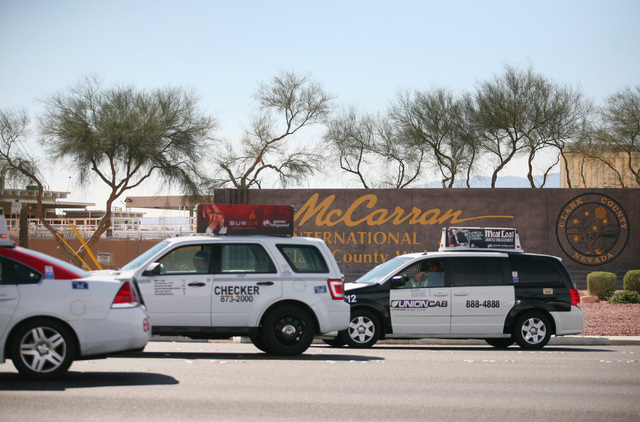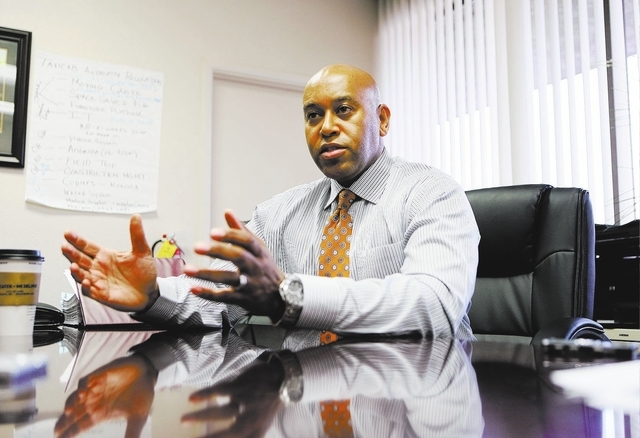Long-hauling cabbies prey on locals, tourists as citations decline
The Nevada Taxicab Authority remains gridlocked in its efforts to clamp down on the practice that regularly gives the Southern Nevada tourism industry one of its biggest black eyes — illegal long-hauling to jack up fares.
Charles Harvey, a self-described fix-it man recruited in 2011 to overhaul the state agency that regulates 16 Clark County cab companies and their 3,000 vehicles, has said he is emphasizing a crackdown on long-hauling.
But the agency ended 2013 on a low note: Just two long-hauling citations written in December, the lowest monthly total in two years.
That slow month capped a long falloff in citations for the agency, which issued 425 tickets in 2012 but only 225 in all of 2013.
Wayne Smith was a Clark County Department of Aviation transportation shift supervisor based at McCarran International Airport until his retirement last July.
Smith said he heard daily complaints from travelers about long-hauling. “Frankly, there were some days I’d get a dozen,” he said.
When told of the most recent statistics, Smith said, “That tells me they’re not enforcing it. I would call it ridiculous.”
LONG-HAULING A MONEY-MAKER
Put simply, long-hauling involves taking passengers on a longer route than necessary, without their permission or knowledge, to run up the fare.
McCarran, the point of arrival for millions of tourists each year, is the epicenter of the practice as unscrupulous drivers get to the Strip and downtown Las Vegas via the McCarran bypass tunnel connecting to the 215 Beltway and Interstate 15, rather than shorter runs on surface streets.
The difference adds about $10 to a fare.
On average, nearly 10,000 cab rides start at McCarran each day.
State auditors last year estimated that nearly a fourth of trips from the airport to Strip hotels were long-hauls, bilking travelers out of almost $15 million in unjustified extra fares per year.
Smith said an authority investigator could expect to find 20 to 25 long-haulers using the airport tunnel route between 8 a.m. and midnight.
“Anybody with eyes in their head can look at the volume of taxis going out the tunnel,” he said.
But if investigators do see them, they are not citing them.
An analysis of statistics from the authority and other sources shows:
■ In 2013, monthly totals for long-haul citations ranged from those two in December to a high of 28 in February. The monthly average was 18.75.
■ In 2012, the monthly average for long-haul citations was 35.4. The authority issued a total of 425 long haul citations, an average of less than two a day.
■ Overall citations for all offenses, not just long hauling, also have dropped. In 2013, the authority wrote 2,620 tickets. That’s a drop of 32 percent, or 1,253 fewer than in 2012, when investigators wrote 3,873 citations.
The authority, with an annual budget of about $3.49 million, has about 26 investigators. They are sworn law enforcement officers with the ability to issue citations and respond to traffic accidents and crimes involving cabdrivers or passengers.
Long-standing problems within the authority have come to light in recent months. Those problems include revelation of a recorded conversation between the authority’s chief investigator, Ruben Aquino, and another investigator, Chris Rivers.
In December 2012, Aquino and Rivers were heard casually discussing cab companies effectively overseeing the authority’s day-to-day operations and acknowledged that they cannot be as heavy-handed as Metropolitan Police Department officers, court records show.
The casual acknowledgement of the agency’s perceived oversight by the industry sparked concerns among other agency staffers.
Joseph Morgan, an authority investigator, overheard the conversation and allegedly recorded it, court records show. Morgan and another investigator later emailed colleagues and state authorities expressing concerns about the conversation.
Morgan now faces criminal charges stemming from accusations that he illegally recorded the conversation.
Harvey linked the decline in citations to agency personnel issues.
The same month in which the conversation between Aquino and Rivers occurred, citations started to drop significantly.
Investigators wrote 76 long-hauling citations in November 2012, a monthly record for 2012 and 2013. But that figure dropped to just 24 the following month, and to 13 in January 2013.
When it was named the Nevada Department of Business and Industry’s “agency of the year” in January 2013, the authority announced it had issued 613 long-hauling citations in 2012, crediting “proactive and aggressive enforcement campaigns.”
In reality, 425 were written. The authority’s top month for long-hauling citations in 2013 was August, when 27 were issued, an average of about one for the month for each of its 26 investigators.
Harvey, in a recent interview, admitted the 2012 statistics were inflated. He blamed the discrepancy on variations in the way the authority’s departments logged dispatch calls.
But the number of citations issued dropped still further last year, to 225 for all of 2013.
While not fully vouching for the accuracy of the most recent figures, Harvey said he still uses them internally to seek ways for improvement. On Jan. 21, Harvey emailed authority supervisors about the decline.
“Can anyone explain why this is occurring or have any suggestions or recommendation?” Harvey wrote. “Additionally, as leaders in the Compliance/Enforcement Division, what results are you working to achieve, and how can you involve your team in formulating & achieving those results?”
RESISTANCE TO CHANGE
Answers to that question vary.
Harvey insists the agency has made long-hauling a priority and is making strides in combating it.
For example, the authority has posted fare information advisory signs at the airport, he noted. Harvey also said he has had discussions with the industry and formed groups to look at long-hauling and other issues.
And Harvey points out that he recently made it easier for investigators by eliminating a requirement that a cab passenger must sign an affidavit before a long-hauling ticket can be issued.
Meanwhile, he is trying to change the agency’s enforcement culture from that of a crime-busting police force to more of a regulatory body.
Some officers didn’t buy in, Harvey said, leading to conflict between those backing culture change and employees who consider a civilian such as himself unqualified to lead a police agency.
Harvey formerly was director of Nevada’s office for the American Reinvestment and Recovery Act and before that was a 13-year Clark County employee.
Harvey said employee turnover through attrition and personnel actions, including administrative leave for some officers, plays a part in the drop in citations.
He also said investigators resistant to change are writing fewer citations in an effort to undermine him.
“If your goal is to replace the administrator, what do you do?” he asked. “You don’t write citations.”
He would not say how many investigators he considers resistant, but said, “This runs much deeper than any of you can imagine.”
In an interview, Aquino said the figures can vary by month for a variety of reasons.
For example, he said, investigators can spend their time dealing with other concerns, such as traffic accidents.
The authority also trains new officers, which requires an investment of time from other staffers and takes them off the street, he said.
Investigators with accrued paid time off can lose it if they don’t use it by the end of the year, another potential factor that impacts December enforcement, he said.
Aquino would not comment on the recorded conversation. He defended his record and ability to do the job.
“I do know how to do it, despite what others have claimed,” he said. “But that’s for people to determine. But, I would have to say the record speaks for itself. My record speaks for itself.”
Harvey and Aquino pointed to last month’s figures: 114 long-hauling citations, the highest of any month in the past four years and way up from the 18 issued in January.
In interviews, investigators have said attention to long-hauling enforcement ramped up in the wake of Review-Journal articles last month about the authority’s lax enforcement practices.
Aquino and Harvey say that’s not the case, pointing to Harvey’s correspondence from late January asking about low citation figures.
They also point to other records, including a note Harvey sent to staffers in September 2012 that said investigators wrote an “unprecedented number of citations producing commendable results.”
Investigators interviewed for this article say the figures show the authority discourages enforcement, particularly for long-hauling, and has onerous paperwork requirements that undercut the effort by keeping them out of the field.
They also say the dismal numbers show Harvey has fallen short in his mission to reform the authority and that the figures prove the case that the authority’s administration doesn’t put an emphasis on enforcing the law.
The investigators requested anonymity, fearing retribution for speaking publicly. They said long-hauling remains a persistent problem, with ample opportunities to write multiple citations if the authority administration didn’t discourage it.
Harvey apparently has the support of the taxi industry, however. Last month, the five-member authority board appointed by the governor praised Harvey and his big-picture approach in solving industry problems, and criticized media reports about the drop in long-hauling citations.
Cab company owners chimed in at the meeting, too.
Brent Bell, president of Whittlesea-Bell Transportation, which operates two local cab companies, said he believes Harvey has made “tremendous progress” at the agency.
“I think people don’t realize that the agency has a lot more to do than enforce long-hauling,” he said.
Bill Shranko of Yellow Checker Star, the second-largest cab operator in the county, said: “Mr. Harvey is in a no-win situation. Maybe there aren’t as many citations (for long-hauling) because what he’s doing is working.”
Harvey echoed Shranko’s assessment. While saying there is no specific number for use in gauging the authority’s effectiveness, he said it’s logical that the desired drop in long-hauling would result in fewer citations written.
But state officials do look at the numbers.
Bruce Breslow, Harvey’s boss as director of the Nevada Department of Business and Industry, wrote last week in an email to all authority staffers:
“It’s one thing to talk about it, but we must also show, in the number of citations written, that we are putting a dent into the practice of long hauling.”
Breslow acknowledged long-hauling remains a problem, but said, “The Governor and I have confidence in Administrator Charles Harvey as well as you employees of the Taxicab Authority.”
FUTURE EFFORTS
The agency should get a morale boost in a couple of months when it moves to a more modern headquarters at 2090 E. Flamingo Road, closer to the airport, the Strip and the Las Vegas Convention Center — places where the agency does the bulk of its work.
Harvey also is asking the state for more staff to increase enforcement at the airport, as well as computer upgrades and other technology for statistical analysis needed to better target enforcement.
New technology may prove the most effective weapon in the fight against long-hauling.
In late 2012, Frias Transportation Management, which runs Southern Nevada’s largest cab fleet under five companies, rolled out RideIntegrity, a real-time GPS-based tracking system that could help regulators monitor cab movements.
Frias, under its Integrity Vehicle Solutions subsidiary, persuaded the Taxicab Authority to try the tracking system in a 300-cab pilot program.
Meanwhile, the Nevada Transportation Authority, which oversees buses and limousines as well as taxis outside of Clark County, last month started looking at vehicle monitoring systems.
The Taxicab Authority plans system presentations by May, and hopes to develop a request for vendor proposals and a competitive bid process culminating next fall, ahead of legislative budget requests.
Harvey said he is enthusiastic about using new technology to catch long-haulers, but he said proper use of the trackers will mean a further fall in citation volume as drivers realize it’s harder to fool customers or law enforcement.
Under one proposal, cabs would be fitted with monitors displaying approximate costs of alternate routes to destinations requested.
The passenger could then choose the route, and any deviation without a legitimate reason would generate an email alert to the authority.
Harvey noted that some systems being studied have other useful applications.
In San Francisco, regulators use RideIntegrity to detect speeding in busy pedestrian corridors. The system can also be set up to allow cabs to be dispatched directly in response to a customer’s email.
Some systems also link to downloadable apps that enable passengers to monitor their route and fare on their smartphones. Others link to credit-card payment options that make it easier for passengers to pay for their rides and give a tip.
But all of the new technology comes at a price, and it’s too early to tell how much it would be.
Contact reporter Ben Botkin at bbotkin@reviewjournal.com or 702-405-9781. Follow him on Twitter @BenBotkin1. Contact reporter Richard N. Velotta at rvelotta@reviewjournal.com or 702-477-3893. Follow him on Twitter @RickVelotta.
Long-haul citations issued
Month, 2012, 2013
January, 6, 13
February, 8, 28
March, 2, 11
April, 3, 21
May, 3, 7
June, 49, 20
July, 57, 26
August, 68, 27
September, 73, 22
October, 56, 24
November, 76, 24
December, 24, 2
Annual totals: 425, 225
Source: Nevada Taxicab Authority




















